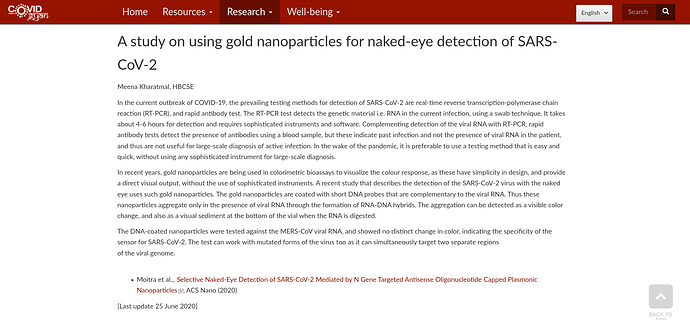We have been having quite an engaging and continuous discussion on non-invasive testing methods for the detection of SARS-CoV-2. Quite a lot of recent research studies are posted by @jtd and @vvcstemplay regularly. One of the suggestions has been:
A blurb was written on this article and has been published on CovidGyan website:
As the article was written as a blurb, it needed to be in the short and simpler text. Here is the extended version of the blurb for a quick overview of the study, principles, methodology used by the researchers. This article has quite an intersection of physics, chemistry using it for a subject of the virus.
In the current outbreak of COVID-19, the prevailing testing methods for detection of SARS-CoV-2 are real-time reverse transcription polymerase chain reaction (RT-PCR), and rapid antibody test. The RT-PCR test detects the genetic material i.e. RNA in the current infection, using a swab technique. It takes about 4-6 hours for detection and requires sophisticated instruments and software. The rapid antibody test detects the presence of antibodies using blood sample, placed on a kit with markers. It takes about 30 minutes, and can detect the past infection. These techniques are dependent on sophisticated instruments to detect the infection and takes several hours. In the wake of the pandemic, it is preferrable that a testing method that is easy, quick, without any sophisticated instrument is made available for a large scale diagnosis.
In recent years, gold nanoparticles (AuNPs) are being used in colorimetric bioassays to visualize colour response, as these have simplicity in design, provide visual output, without use of sophisticated instruments. The study reports, use of gold nanoparticles capped with thiol-modified antisense oligonucleotides (ASOs) for reaction with nucleocapsid phosphoprotein of SARS-CoV-2. Oligoneuclotides comprising of smaller number of nucleotides, are used as probes for detecting specific sequences. Antisense is the non-coding DNA strand of a gene, used with the oligoneucleotides.
The viral load with a composite of ASO-capped AuNPs was initiated with incubation of 5 min room temperature. The ASO-capped AuNPs gets accmulated selectively due to the presence of RNA sequence of SARS-CoV-2 and demonstrate change in its surface plasmon resonance (SPR) with a redshift of ∼40 nm in their absorbance spectra. The SPR is an optical effect, used to measure binding of molecules by change in the intensity of light. This is followed by treatment of RNaseH at 65°C for 5 min that cleaves the RNA strand from the RNA-DNA hybrid resulting into a visual precipitate from the solution. The accumulation (agglomeration) was studied by UV-visible absorbance spectroscopy.
Validity of the biosensor was tested against MERS-CoV viral RNA load, showing no distinct change in the specific absorbance. Feasibility of the test is claimed, that it can work with the mutated virus as it can simultaneously target two separate regions of the gene.
